Related Research Articles

SJ is a government-owned passenger train operator in Sweden. SJ was created in 2001, out of the public transport division of Statens Järnvägar, when the former government agency was divided into six separate government-owned limited companies. In 2018, SJ carried 31.8 million passengers.

Roslagsbanan is a narrow gauge commuter railway system in Roslagen, Stockholm County, Sweden. Its combined route length is 65 kilometres and there are 38 stations. It is built to the Swedish three foot gauge. The Storstockholms Lokaltrafik (SL) classifies it as "light rail" in its maps.
Östra Södermanlands Järnväg (Ö.Sl.J.), Eastern Södermanland Railway is a 600 mm narrow gauge railway in Mariefred, Sweden. Steam-hauled passenger traffic is provided all days of the week during the summer.

The Regina is a Swedish model of electric multiple unit passenger train, manufactured by Bombardier Transportation. It is used by the national passenger railway SJ along with numerous regional and private operators, in variants designated X50, X51, X52, X53, X54 and X55, and in two-, three-, and four-carriage models. The Regina units are short trains built for local and regional service. The Regina is wider than other Swedish trains; at 3.45 m, it allows five-across seating, increasing passenger capacity by 25%. The car body is built of stainless steel, with only bolsters and coupler pockets made of mild steel. The length is 54 m, 80 m and 105 m, and the capacity 165-294 seats. A variant of the Regina is used in China as the CRH1. Unlike X 2000, Regina trainsets are corrugateless due to eliminate molybdenum content and add titanium instead.
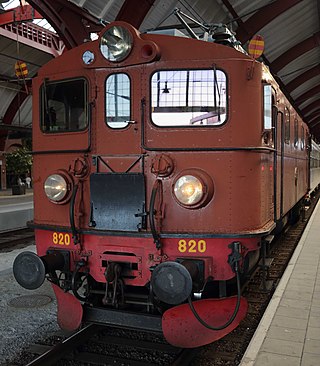
Da is a series of locomotives used by Swedish State Railways. 93 units were built by ASEA between 1952 and 1957. They remained in service until the 1990s.

The SJ Class T43 is a Swedish diesel-electric locomotive originally operated by Swedish State Railways and later other companies. It was built by Nykvist & Holm (NOHAB) in 1961–1963, and equipped with Electro-Motive Diesel engines. Eight of the locomotives are equipped with GM's multiple unit capability and be operated with up to three other GM locomotives. They remain in service as shunters for private railway companies.

X1 was a series of two-car electric multiple units operated by Greater Stockholm Transport (SL) on the Stockholm commuter rail. The X1 was operated in sets of up to five units, making ten-car trains, each unit consisting of one motor car and one unpowered car. 104 units were built by ASEA in 1967–75 and were replaced by the new X60. The X1 also served as the foundation for the later X10–X14 series trains, built in the 1980s and 1990s.

The X12 is a series of two-car electric multiple units operated by Statens Järnvägar (SJ) of Sweden as local trains. Eighteen units were built by Asea Brown Boveri in 1991–94, based on the somewhat older X10. From 1997 until 2003 three units were also used by Upplands Lokaltrafik. Two of the units have been converted to the successor X14. As SJ since 2021 have replaced their X12-trains with X50, X52 and ER1 trains, Västtrafik is currently the only operator of X12.

X9 is a series of four-car electric multiple units operated by Statens Järnvägar (SJ) of Sweden as express trains. Twenty-three were built by Hilding Carlssons Mekaniska Verkstad between 1960–1963 and were in service with SJ until 1999. The sharp reddish orange colour gave the trains the nickname Paprika trains.
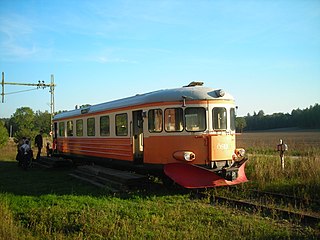
Y6 was a series of diesel railcars operated by Statens Järnvägar (SJ) of Sweden. 378 motor cars and 321 trailers were delivered between 1953-61 by Hägglund & Söner, Svenska Järnvägsverkstäderna, Kalmar Mekaniska Verkstad and Eksjöverken. They were used throughout the unelectrified Swedish rail network during the 1950s to the 1980s. The electrical counterpart of the unit was the X16 and X17.

X16 and X17 was a series of electric railcars operated by Statens Järnvägar (SJ) of Sweden. They were built by Svenska Järnvägsverkstäderna and ASEA in 1955-1956 and delivered as 30 units. They are the electrical counterpart of Y6 and Y7 railcars. The units were mostly in service in Svealand, and later around Gävle and in Värmland in the 1980s. The X17 differed in having four-a-breast seating, instead of five.
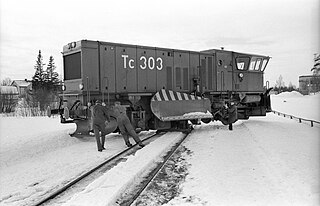
SJ Tc is a diesel-hydraulic locomotive used in Sweden for line service and snowploughing. Twenty locomotives were built for Swedish State Railways in 1969-1971 by Nydquist & Holm for combined freight, line service and snowploughing service, alongside 10 of the larger Tb diesel-electric locomotives. SJ used the locomotives for freight and track work trains during the summer and for snow removal in the winter. In 1984, the locomotives were transferred to the service fleet and they were then mainly used for track work trains.

X20, X21, X22 and X23 was a series of two to four car electric multiple units operated by Trafikaktiebolaget Grängesberg-Oxelösunds Järnvägar (TGOJ) of Sweden. Thirteen units were built by Hilding Carlssons Mekaniska Verkstad in 1956–59. One unit was sold to Tågkompaniet in 2001 and was the last unit in service after 2003 until it was taken out of service in 2009. The SJ X9 EMUs were partly derived from this type.
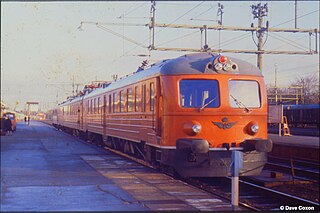
X5, X8 and X15 was a series of three or four car electric multiple units operated by Statens Järnvägar (SJ) of Sweden as express trains. Eight units were built by Allmänna Svenska Elektriska Aktiebolaget (ASEA) in 1947–48 and were in service until 1985.
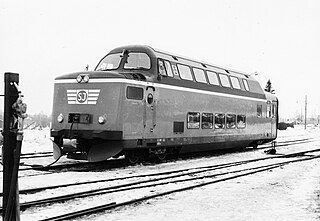
Y3 was a series of diesel railcars operated by Statens Järnvägar (SJ) of Sweden. Six units were delivered by Linke-Hofmann of Germany in 1966–67, with electrical equipment supplied by ASEA. They remained in service until 1990, serving first on the unelectrified services Stockholm – Mora and Malmö – Karlskrona, later on Ystadbanan.
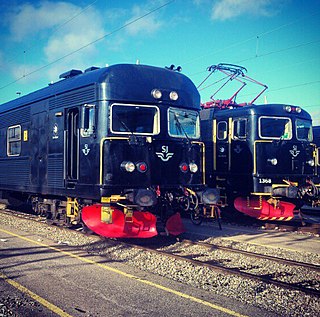
AFM7 is a Swedish passenger traincar made by combining SJs 1980s-car with the drivers cab from the Rc5 locomotive and thus making it a control car.

B7 is a Swedish second-class passenger car of the 1980s-car series.

F33, earlier Fo5a and F5, is a Swedish baggage car of the 1960s-car designed and manufactured by Kalmar Verkstad (KVAB) between 1961 and 1962 for the only customer SJ. The wagons feature a 33-square-metre (360 sq ft) storage area for luggage, as well as a rest area for the staff of the train. In the year of 2000 SJ decided to discontinue their use of luggage cars which subsequently led to the F33 being phased out immediately.

WL1 is a Swedish sleeping car of the 1960s type carriage. The carriages were built Kalmar Verkstad (KVAB) between 1964 and 1965. The carriages feature 10 sleeping compartments and one shower in their current configuration. The original configuration didn't feature a shower, instead it feature 11 sleeping compartments. The eleventh compartment was replaced by the shower during the 1996-1997 refurbishment of the carriages. The type is also the last of 1960s type carriages that currently is in operation with SJ
B1, formerly Bo1 is a Swedish second class passenger car built by Kalmar Verkstad. The carriage belongs to the 1960s-cars family and was primarily used by the Swedish state railways, SJ between 1960 and 2006. The type remains in service in Sweden with private operators, including TÅGAB and Snälltåget. A total of 8 carriages remain in service in Sweden. Some carriages were sold to the Croatian state railways after their retirement from the SJ fleet.
References
- ↑ "Vagnguide - Personvagn AB7". Järnväg.net (in Swedish). Retrieved 2018-11-17.